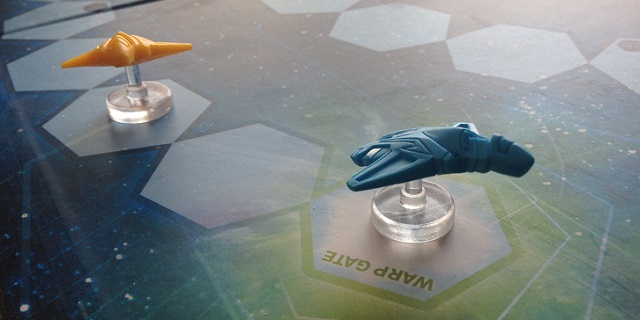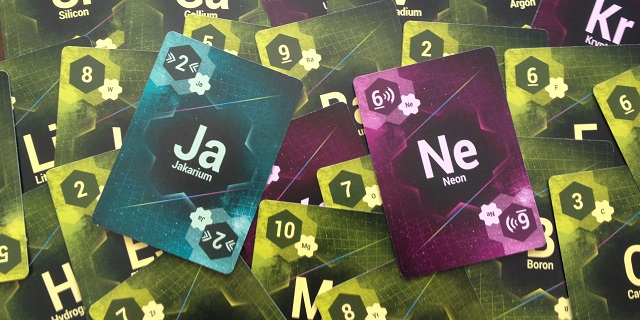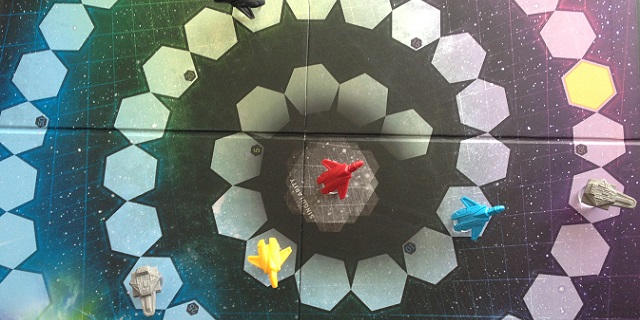
How hard can it be to move from point A to point B? A lot of the most basic games out there have this as their sole mechanic: Candy Land, Chutes/Snakes and Ladders, Sorry!, Trouble and many others. It’s not usually a premise we see in modern, European-style board games, although you can still distill a few of them down to this simple challenge, like RoboRally or River Dragons. Gravwell: Escape from the 9th Dimension, the debut design from Corey Young (published by Cryptozoic), asks this in the most straightforward manner yet. All you have to do to win is advance 54 spaces from the center of the board to the end of the single track. Sounds easy enough, right?
Obviously it’s not that simple, but it sure looks that way. Gravwell‘s board is just a 55-space spiral with no branching paths or special spaces that do weird things when you land on them. Aside from the players’ ships clustered in the “singularity” in the middle, the only other parts are two derelict ships placed on indicated spaces and a mere 26 cards.
These cards feature numbers from one through ten and element symbols that occupy every space from A to Z. In each of the six possible rounds, a subset of these cards will be drafted by the players until each has a six-card hand. Players select their card for the turn simultaneously, and then they are resolved in alphabetical order. Still sounds simple — and let’s be honest, not much of a game — yes?

Well there are two twists that make Gravwell amazingly fun. The most important is that when your card resolves, instead of always moving forward, you instead move toward the closest ship. If that ship is in front of you, you move forward. If it’s behind you… you move backward. Ties are broken by which direction has the most ships; in a three-player game, it is possible to have an equal number on either side and thus not move at all!
This is where the order of resolution is so important. You have to try and anticipate when your opponents will move and in which direction, and hope that the card you’ve chosen will let you advance when you get to act. Once per round, you can opt to use your “emergency stop” to cancel your own movement. As an added level of strategy, you can also use your stop offensively, sacrificing your move to screw over one or more players moving after you.
The other complication is that not every card moves you toward other ships. Four cards are “repulsors” that move you away from the nearest ship. While especially useful when you’re in the lead, the earliest time one of these can act is on K so you can’t count on that every time. The final two cards are “tractor beams” that do not move you at all, and instead pull every other ship towards you two or three spaces. As you might expect, this can really mess up the plans of everyone else. To subtly emphasize their weird nature, these cards represent fictitious J and Q elements.

Not that anyone but the staunchest of chemistry geeks will be paying attention to the actual elements listed on the cards, because most players will be too busy trying to wrap their heads around Gravwell‘s simple-yet-unintuitive rules. It seems random at first glace, to be honest. The strategy here is in keeping track of which cards have been played, which ones are still potentially out there and how to best play your remaining cards to best take advantage of this. It might not always work out that way in practice, but that’s part of the fun.
While the slingshot movement makes the game fun to play, my favorite part of Gravwell is its overall simplicity. It really is something of a masterpiece in elegant design: one board, six pawns, 30 cards (including the four “emergency stop” cards) and a rule book that is more examples of movement than it is actual rules. Corey Young’s first design makes me eager to see more from him in the future. Until then, I anticipate many more attempts to escape the ninth dimension in my future.
Gravwell retails for $35.



















